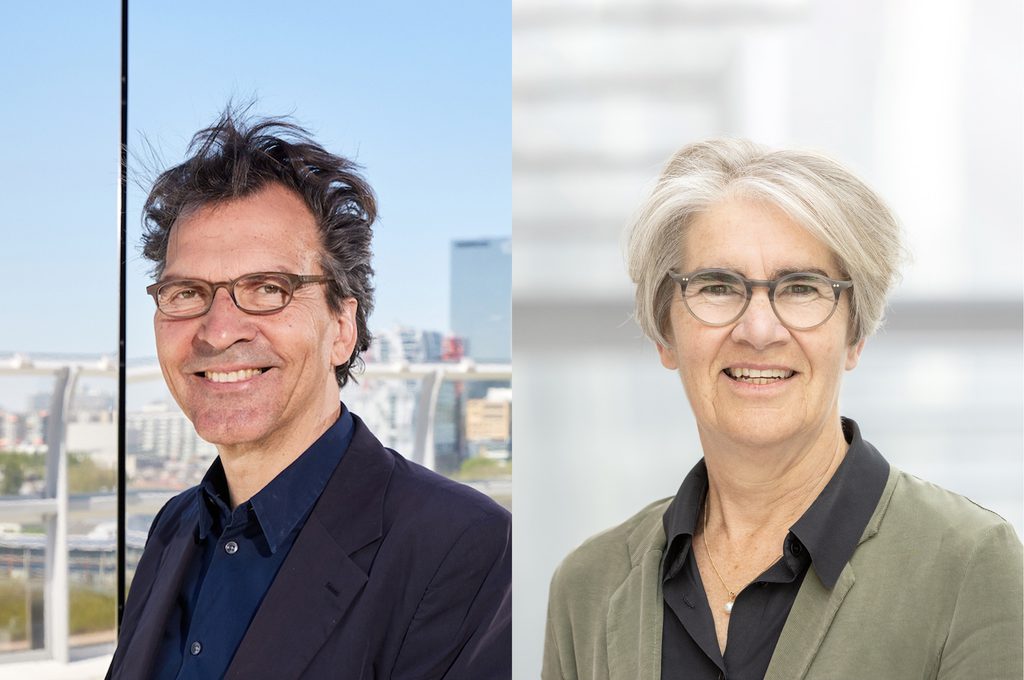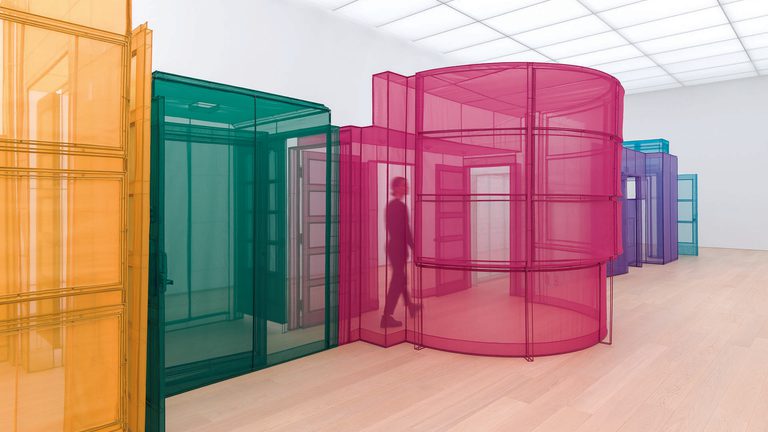Interior designer Det van Oers explores with former museum director Sjarel Ex the principle of borders - who erects them, why, and do they actually exist?
Det: ‘After I graduated from the Rietveld Academy, you exhibited my graduation project in the Agnietenkapel of the Centraal Museum. It impressed me that you saw something in it, but especially that you did this just like that, and didn't think in boxes. In that sense, you are an example for me.'
Sjarel: ‘Your graduation work was good and was about a paternoster, which suited there. The paternoster speaks to the imagination anyway, my most ideal museum ever consists of a large, empty room and four or five towers with paternosters, so that the art is constantly passing by. Did anything actually come out of it then?'
Det: ‘Sure, after that I was able to start at Kho Liang Ie Associates, not the least.’
Sjarel: ‘I think there is too little experimentation, maybe my choice had something to do with that too. Not that I experiment for the sake of experimenting. My guiding principle is: go off impressions, combine rather than reduce, and be open to new things.'
Det: ‘To experiment or not to experiment has to do with limitation, or feeling limited.’
Sjarel: ‘People like to let themselves be limited, because it's easier. You can then objectively say: ‘That's all there was to it’. I constantly look at how my work develops. A third of the quality arises during the work, but such progressive insight needs space. You have to factor that into your plan and budget.'
Det: ‘If you work in a team, when a change is proposed, people will not immediately be on the same page. How do you get people on board, how do you share progressive insight?
Sjarel: ‘It's a role you play, in which images are important. Of course, we sometimes write and read Baudrillard, but our profession is mainly visual.'
Det: ‘That also makes it subjective, with the image alone you're not there yet.’
Sjarel: ‘It starts with trust, you have to earn that. Then comes the role of the sculpture. Building the Depot in Rotterdam was absolutely not an obvious choice, it was too expensive and the location was debatable. I triggered thinking about it with a photo of me, with blue plastic bags around my legs, among the stored art objects in Boymans' flooded basement. A bit phoney, but the necessity permeated. The next strong image was a big blue table by way of a depot, across Museumplein, which was then set as a 1:10 model across the Kunst Rai. ‘If you think steps ahead and convey strong images with conviction, you will get people on board.’
Det: ‘I often feel at tenders that creativity is beaten to death by all the boxes that have to be ticked off. There is little room for progressive insight there.'
Sjarel: ‘It's all fear of what might go wrong, whereas it should be about what is possible. To change, 70 per cent invariably say no. Sometimes you have to be bold. Although there is always a limit to the one you ignore. A fact that is interestingly culturally determined.'
Det: ‘Advancing insight tends, as the word suggests, to advance. How do you know you're there?'
Sjarel: ‘When you arrive at something new?’
Det: ‘I see every task as something new, no choice is fixed beforehand. That way you can always improve yourself.'
Sjarel: ‘I mean it more mentally. The process of thinking of something, believing in it, doubting it, going ahead anyway, is always the same. Any creative process depends on your mental condition, it's like something that turns you on, that source is essential.'
Det: ‘Do you relate a person's qualities to that source? I ask because I myself sometimes struggle with the boundaries between disciplines. At cepezed, where many designers work who come from TU, I sometimes feel like an odd man out with my art academy background. Because an architect works from the outside in, and an interior designer from the inside out, my approach and way of thinking differ. I really like the design for the cultural centre in Oss, a circular project we are currently working on, because we are actually creating a gesamtkunstwerk there, with designers from different disciplines. I also always find it inspiring and surprising to involve an artist in our work.'
Sjarel: ‘That also requires trust within a team, you have to be given room to zigzag. Incidentally, my experience over the past 40 years is that the artists within a team often have the convincing ideas. And Carlo Scarpa... who just did everything, very precisely.'
Det: ‘Oh, Scarpa! In my second year at the academy, we took an impressive Scarpa tour of Italy. For a long time, artists like Scarpa were sculptor, furniture maker, glassblower, architect, all at once. Now those roles are split and delineated. I would love to reverse that.'
Sjarel: ‘You should definitely do that! You're in a strategic position, where you can combine. Combining is a real profession, like composing and conducting. You have to combine first and then demarque. And then demarche of course, but it's all about the right thing in the right place.'
Det: ‘Mm, I'm associative and combine in that way all the time.’
Sjarel: ‘At cepezed, you now create a visual, associative system with the wunderkammer. A wunderkammer shows how inspiring things can be, I'm a fan of it. The materiality, the associative field around objects, that is information you are not immediately aware of, but which you pick up.'
the transition of the imagination


Det: ‘A different setting does a lot anyway, with things and with people. That's why museums appeal to me so much. By the way, one of the most beautiful exhibitions in recent years was Do Hu Suh's in Museum Voorlinden. In his work, boundaries are wonderfully diffuse. Whereas in a renovation assignment, I find the hard boundary of the existing building interesting.'
Sjarel: ‘If you link your design to the soul of the building, you can hardly go wrong. The soul speaks the most from the original situation, sometimes even the most from the original drawing. The longer you stay away from a building, the more the soul becomes visible. A renovation design is a matter of deduction.'
Det: ‘In the renovation of the concert hall, which I designed while working at Merkx + Girod, there was a continuous tension between preservation and intervention. In my experience, it helps to explain it to the people at Monumentenzorg on the spot when you propose something intrusive.'
Sjarel: ‘That's what I mean by using the eye as a persuasive tool.’
Det: ‘First there was a no...’
Sjarel: ‘...then the transition of imagination. Dynamics are so much more important than the static, I think.'
Det: ‘It reminds me of one of your first art projects, Century 87. At the time, you convinced the hortulanus of the Amsterdam Hortus, among others, and then Daan van Golden filled the paths of the hortus with blue gravel. Anyway, this was a fantastic exhibition, with contemporary art in unusual, historical places in Amsterdam.'
Sjarel: ‘The hortus had just been divested by the university and that hortulanus, Mr Wiering, first thought about that blue gravel “this is the beginning of the end”. The opposite turned out to be true.'
Det: ‘It was a high-profile exhibition.’
Sjarel: ‘Zantkuijl, the director of Bureau Monumentenzorg, thought it was great. We gave the monuments space, air and eyes, we made them talk. For us, this exhibition was about the soul of buildings. Some artists subtly shaped that, others preferred to chain. Those methods stood side by side.'
Det: ‘After Century 87, you organised the exhibitions Night Rules and Panorama 2000 in Utrecht - outside the museum - and in the corona period you set up an exhibition in the Ahoy hall, which could be visited “drive thru” by car. Is exhibiting art outside the museum your calling?'
Sjarel: ‘Nice question, yes, public space is boundless and it appeals to me that the entire city can be an exhibition space. Funny really, because the principle of museums actually started very small, with the dolls' houses of wealthy 17th-century ladies. They chose fancy wallpaper and hired real artists for the paintings in their dollhouse rooms. In itself, crossing borders is not a virtue. Actually, borders are quite nice, because you can give people something they didn't know before.'
Det van Oers is an interior designer and directs cepezedinterieur.
Sjarel Ex is an art historian and was director of the Centraal Museum in Utrecht (1988-2004) and Museum Boijmans Van Beuningen in Rotterdam (2004-2022).
→ return to overview
→ Mail bd@cepezed.nl or call our business development team on +31 (0)15 2150000